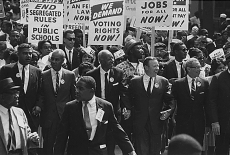
Protest songs were another clear push for democracy; staunchly political, and openly criticising flaws within society, all the while, drawing the public together in an effort for moving towards change. Bob Dylan’s, ‘Times they are a changin’’ is perhaps one of the most famous of such songs of all time. Lyrically, it certainly reflects the ‘music of the people,’ by referencing all demographics of society; ‘Come Writers and Critics…Come senators, Congressmen… Come Mothers and Fathers.’ The song continues to use the semantics of War and battles, to get across the idea of the fight of the African American peoples against the injustices they suffered. For example, ‘Please heed the call,’ brings to mind not just rallying voices crying out to troops in battle, but also the infamous bugle call, made all the more powerful by such subtle phrasing. ‘There’s a battle outside, and it is ragin’’ is much more explicit, but serves to make the plight of the people more real. By defining it as a matter of life and death through the inclusion of a metaphor, it suggests to those listening and those singing alike, that the situation in America at the time was a matter of life and death; people were dying due to racist attacks and police brutality, along with the less literal sense, wherein people were being completely stifled and oppressed due to segregation and lack of rights, such as that key right to vote and thus to feel that you have a voice that is being heard, a voice wherein you can affect positive change within your country; your home.
Interestingly enough, Dylan’s protest song that so strongly defined the African-American identity, was inspired by ballads of Scottish and Irish origin; this is partially down to the link with Folk music, and the Folk music movement that ‘allied’ itself to the causes of the Civil Rights Movement at the time. Protest songs were key for uniting people to fight against a cause, and also as a source of motivation for marches. Marches were a popular form of non-violent protest, that nonetheless received backlash from the public and police alike. The March from Selma to Montgomery, lead by Martin Luther King is one of the most famous examples, wherein King decided to turn attention towards Selma, and towards attaining the vote for African-Americans in this area; it was notorious for this not being the case, with both the Governor and Sheriff having deep-seated oppositions to African-Americans having the right to vote. Despite the peaceful nature of this march, many attempts were made to stop the protesters. Marches were long, arduous, and subject to scrutiny and prejudice, and as such, it was crucial to have songs that people could easily learn and remember, and that conveyed to all onlookers what they were protesting about.
Image:https://en.wikipedia.org/wiki/African-American_Civil_Rights_Movement_(1954–68)

0 Comment:
Be the first one to comment on this article.